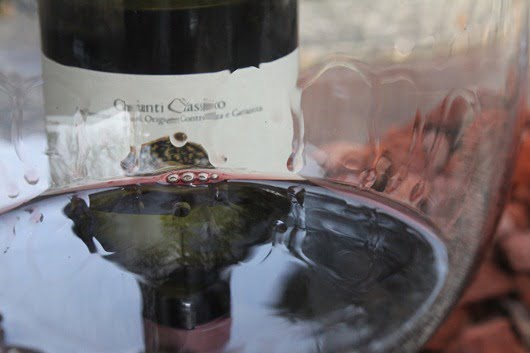Querceto di Castellina L’Aura Chianti Classico, Tuscany, Italy, 2008.
January 25, 2012
Grapes
90% Sangiovese, 10% Ciliegiolo
- Sangiovese [san-joe-vay-zee] is the main grape in Chianti, Vino Nobile di Montepulciano, Carmignano and Brunello di Montalcino.
- Ciliegiolo [chee-lee-eh-joh-loh] is a much more obscure grape than Sangio, and it took a little research to find out some info! We’re all still learning, right?
The name is apparently derived from the Italian word for cherry in Italian: ciliegi. Through clonal research, Ciliegiolo has been discovered to be the parent of the Sangiovese grape.

Facts
- There’s a lot of confusion amongst consumers with regard to the labeling of Italian wines, especially the difference between Chianti and Chianti Classico. The main thing to remember is that Chianti Classico wines have to adhere to much stricter guidelines.
- Chianti Classico wines must be made up of a minimum 85% Sangiovese (the predominant red grape in Tuscany) with the other 15% begin a blend of other authorized red grapes, in this case: Ciliegiolo.
- With regular Chianti (not bearing the “Classico” designation), they only have to contain 70% Sangiovese, with the other 30% allowed to be made up of a combination of red and white grapes.
- The fact that white grapes are allowed in “regular” Chianti means the wines are ready to drink much sooner, but aren’t capable of aging as long as Chianti Classico wines (as white grapes oxidize quicker than red). Therefore you can expect to usually pay a lower price for Chianti without the Classico designation.
- In the past, the winemaking rules for Chianti were fairly slack, creating problems with quality. It used to be that when people thought about Chianti, they thought about a straw-basket bottle containing thin and watery wine. Luckily for us the situation has improved greatly, with tighter regulations and a new wave of younger winemakers focusing on quality and innovation. Although the stuff in straw-baskets is (for the most part) still garbage!
- The Querceto di Castellina L’Aura Chianti Classico spends 14 months in French oak barrels and 3 months in the bottle before release.

 Place
Place
- There is no doubt that the word “Chianti” confuses a lot of people. The name "Chianti" actually refers to a specific appellation within Tuscany i.e. you can go to Chianti. Chianti is not a grape.
- Tuscany is arguably the most well known of Italy’s wine regions. Wine has been part of the Tuscany landscape for over 3000 years!
- Vineyards thrive EVERYWHERE in Italy. From North to South to East to West you’ll find grapes anywhere you go, and most regions pride themselves on the grapes / wines that are specific to their region. Chianti is the real cash cow of Tuscany.
- The hilly terrain and sunny weather patterns make Tuscany the perfect home for Sangiovese. The grape is fairly thin-skinned, but still needs plenty of sunlight to ripen.

Taste
Dark brooding black fruit on the nose, stewed strawberries, herbs, clove and a little “Old World Funk” . The palate shows….
“Hang on… back up…did you just say Old World Funk? What the hell does that mean!?!?”
“Yes I did. What would you prefer I say? “Old World Funk” or “Earthy-barnyardy-spicy-minerally and dusty with often manure-type nuances?”
“Oh, I see. Well let’s stick with Old World Funk…..”
“Thanks! That’s what I thought…”
The palate shows chewy dark cherry, blackberry and ripe raspberry, toasty oak, vanilla, a hint of bitter chocolate and plenty of acidity to give it a lengthy finish. The L’Aura is an excellent value Chianti, and had a lot more life and complexity than I was expecting for the price!
Pairing
Keep it Italian! I always recommend pairing Chianti with food, as I find the Sangiovese grape to pack a great deal of acidity and often tannin (what some might describe as “bitterness”). Saying this, they make the perfect pairing with red sauce pastas, pizzas, herb roasted lamb, game, ratatouille, and even burgers on the grill.
Price
$14.99 – I don’t make a habit of plugging retailers since there’s no “incentive” for me to do so (i.e. $’s), but I picked up this bottle from Total Wine.











